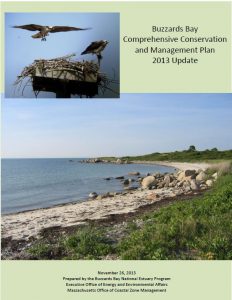2013 CCMP, Action Plan 6:
Managing Impacts from Boating, Marinas, and Moorings
About the new Buzzards Bay CCMP Action Plans
The Buzzards Bay Comprehensive Conservation and Management Plan (CCMP) was updated in November 2013 to reflect the great progress achieved since the original CCMP was finalized. You can download the entire document (buzzards-bay-ccmp-2013-update.pdf) or just this action plan Managing Impacts from Boating, Marinas, and Moorings.
Managing Impacts from Boating, Marinas, and Moorings
Problem
One of the significant accomplishments of the Buzzards Bay Action Committee, on behalf of the watershed municipalities, and with technical assistance from the Buzzards Bay NEP, was the designation of Buzzards Bay as a No Discharge Area for boat sewage in 2000, the first large area to be designated in Massachusetts. How-ever, boats, boat moorings, and marinas can still adversely affect water quality and habitats of Buzzards Bay. These impacts are most pronounced where boat density is greatest or where there are sensitive resources. Boat use and maintenance, and the infrastructure to support those activities, all have potential impacts associated with the release of contaminants, and through physical alterations like propeller wash and anchor chain scour, and through shading of the bottom. Some harbors in Buzzards Bay have more than 1000 moorings. Mooring chains scour the bottom, remove eelgrass, and destroy habitat for benthic fauna. These chains, bouncing on the bottom with waves, resuspend bottom sediments greatly reducing water clarity that can shade out eelgrass beds over large areas and elevate bacteria levels. Some marinas have illicit discharges associated with boat cleaning operations, and 95% of the marinas in Buzzards Bay have not complied with EPA’s Multi-Sector General Permit for managing stormwater discharges. Education is needed about the broader impacts associated with boats, moorings and marinas and how they can be minimized.
Goals
Goal 6.1. Eliminate the discharge of wastewater from all boats in Buzzards Bay.
Goal 6.2. Eliminate or minimize impacts of discharges from marina operations.
Goal 6.3. Eliminate adverse environmental impacts associated with mooring fields.
Objectives
Objective 6.1. To ensure there is an adequate number of pumpout facilities in Buzzards Bay.
Objective 6.2. To promote the use of pumpout facilities by educating boaters, making facilities more accessible, and enforcing the regulations.
Objective 6.3. Achieve full compliance of marinas with the Phase II stormwater and MSGP discharge permits.
Objective 6.4. Ensure compliance of marina power washing activities with applicable state and federal laws.
Objective 6.5. Deploy mooring systems that minimize environmental impacts to habitat and water quality.
Approaches
Goals can be achieved through education efforts, such as the distribution of newsletters, factsheets, and posting of notices or signs. Improved compliance by marinas with the MSGP stormwater permit program will require notification and enforcement by the U.S. EPA, with supporting technical assistance from DEP and CZM. Marina operators must also cease discharges associated with bottom cleaning operations on their proper-ties that result in direct discharges.
Eventually most conventional mooring anchors should be replaced with helical anchors and elastic rodes. Requirements for mooring gear replacement to environmentally friendly types can be mandated through regulations or policies and could be phased in over time to minimize hardships. For example, the Town of Marion now requires helical anchor systems only on vessels over 25 feet (but elastic rodes are not yet required). Environmental moorings have an added benefit of increased boat densities, the same number of boats can be confined to a smaller area of the estuary. Municipalities can lead by example by replacing all municipal owned moorings with these environmentally beneficial mooring systems.
Costs and Financing
Many elements of this action plan require modest or negligible expenditures of public funds, as most relate to education, adoption of regulations, or better enforcement of existing regulations. Most of the necessary flyers and notices can be produced in-house by towns, and disseminated with mooring permits and through marinas.
The most expensive element of this action plan is born by boat owners, and that is the cost of the new mooring system. While these environmentally friendly mooring systems are somewhat higher in price to a con-ventional mooring system ($4-7,000), unless the mooring is new, this is an added cost. Mooring upgrades can be phased in over a period of years. Municipalities should pursue funding for municipal owned mooring replacements from habitat restoration programs.
Measuring Success
The success of this action plan will be documented principally with programmatic actions, the volume of boat waste collected, regulatory compliance, and the extent of use of environmentally friendly moorings.
